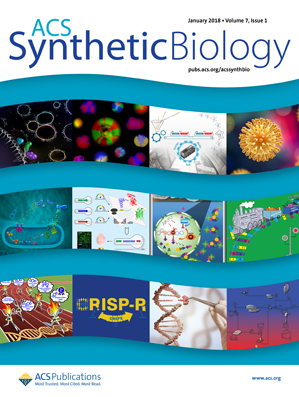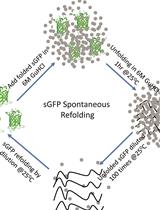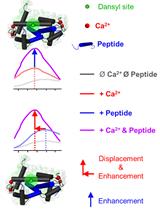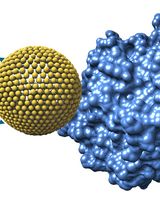- EN - English
- CN - 中文
Preparation of Cell-free Synthesized Proteins Selectively Double Labeled for Single-molecule FRET Studies
用于单分子FRET研究的选择性双标记无细胞合成蛋白质的制备
发布: 2018年06月20日第8卷第12期 DOI: 10.21769/BioProtoc.2881 浏览次数: 7121
评审: Elizabeth LibbyKate HannanAnonymous reviewer(s)
Abstract
Single-molecule FRET (smFRET) is a powerful tool to investigate molecular structures and conformational changes of biological molecules. The technique requires protein samples that are site-specifically equipped with a pair of donor and acceptor fluorophores. Here, we present a detailed protocol for preparing double-labeled proteins for smFRET studies. The protocol describes two cell-free approaches to achieve a selective label scheme that allows the highest possible accuracy in inter‐dye distance determination.
Keywords: Cell-free protein synthesis (无细胞蛋白质合成)Background
Single-molecule FRET (smFRET) is one of the most prominent tools in structural biology, in particular for analyzing structures and functional conformational changes of proteins (Michalet et al., 2006; Roy et al., 2008; Sustarsic and Kapanidis, 2015). However, an extensive application of smFRET is in many cases limited by the elaborative production of suitable protein samples. These proteins need to be equipped with two fluorophores, site-specifically attached at different positions within the protein structure.
The classical cell-based production of proteins requires a sequence of time-consuming steps that can be overcome by employing cell-free protein synthesis (CFPS) systems, allowing a much faster and straightforward production and selection of proper double-labeled proteins. Moreover, another advantage of CFPS is given by the fact that several classes of proteins like proteases or membrane proteins, which are toxic to living cells or for other reasons are difficult to express in cells, can be synthesized successfully in CFPS systems. Finally, CFPS is an ideal tool for labs focusing on spectroscopic techniques like smFRET, since cell cultures are not necessary and safety regulations for recombinant organisms do not have to be considered.
Despite the inherently low sample amounts required for smFRET, CFPS was so far not standardly employed for the production of samples in smFRET studies. This was mostly due to the much lower protein yields as compared to cell-based systems and the lack of an appropriate cell-free approach that allows for a convenient synthesis of adequate amounts of double-labeled protein. However, as demonstrated by our group, thanks to either a much more efficient orthogonal label scheme (Sadoine et al., 2017) or a direct incorporation of dyes with superior photophysical properties (Sadoine et al., 2018), the obtained protein yield from our two cell-free approaches perfectly meets the requirement of related measurements. Combined with state-of-the-art procedures in smFRET studies, the obtained efficiency histograms allow for the highest possible accuracy in inter-dye distance determination the method can deliver today.
Here we present a general combined protocol to be used as a guide for preparing double-labeled proteins suitable for smFRET studies, using either one of the two cell-free methods or a combination of both. CFPS and smFRET represent a perfect combination to achieve the full potential of analyzing protein structures with fluorescence-based techniques and the two presented approaches have the potential to become the standard method to produce protein samples for smFRET studies.
Materials and Reagents
- Eppendorf epT.I.P.S. standard pipette tips (Eppendorf, catalog numbers: 022492004 , 022492047 , 022492055 )
- Eppendorf Safe-Lock tubes 1.5 ml (Eppendorf, catalog number: 022363204 )
- Eppendorf Protein LoBind tubes 1.5 ml (Eppendorf, catalog number: 022431081 )
- Zeba Spin Desalting Columns, 7K MWCO, 0.5 ml (Thermo Fisher Scientific, catalog number: 89882 )
- Coplin staining jar (DWK Life Sciences, Wheaton, catalog number: 900470 )
- High precision coverslides thickness No. 1.5H (Paul Marienfeld GmbH, catalog number: 0107242 )
- RTS 100 Site-specific Label Kit (biotechrabbit, catalog number: BR1402601 )
- Customized Cell-free E. coli-based protein synthesis system (RF1-depleted, w/o Cys) (biotechrabbit)
- SUPERase•InTM RNase inhibitor (Thermo Fisher Scientific, catalog number: AM2694 )
- cOmplete Mini EDTA-free Protease Inhibitor Cocktail (Roche Diagnostics, catalog number: 11836170001 )
- Ni-NTA Magnetic Agarose Beads, 5% suspension (QIAGEN, catalog number: 36111 )
- Alexa Fluor 488 C5-maleimide (Thermo Fisher Scientific, catalog number: A10254 )
- Click-IT Alexa Fluor 647 DIBO alkyne (Thermo Fisher Scientific, catalog number: C10408 )
- Atto633-AF-tRNACUA, amber (ProteinExpress, catalog number: CLD03 )
- BODIPY FL-Cys-tRNACys, cysteine (biotechrabbit, custom made)
- 3-aminopropyltriethoxysilane (APTES) (Sigma-Aldrich, catalog number: 440140 )
- Uvasol acetone (Merck, catalog number: 100022 )
- Uvasol methanol (Merck, catalog number: 106002 )
- Optical glue Norland Optical Adhesive 81 (Norland Products, catalog number: NOA 81 )
- Nitrogen 5.0 gas bottle 99.999% purity, 50 Lt, 200 bar (Linde Gas)
- Sodium bicarbonate (NaHCO3) for molecular biology (Sigma-Aldrich, catalog number: S5761 )
- Methoxy-PolyEthyleneGlycol-Succinimidyl-active ester (PEG-NHS) (Rapp Polymere, catalog number: 125000-35 )
- Phosphate-Buffered Saline (PBS) 10x pH 7.4 for molecular biology (Thermo Fisher Scientific, catalog number: AM9625 )
- Tris(2-carboxyethyl)phosphine hydrochloride (TCEP-HCl) (Thermo Fisher Scientific, PierceTM, catalog number: 20490 )
- 3-(N-Morpholino)propanesulfonic acid (MOPS) buffer grade (AppliChem, catalog number: A1076,1000 )
- Sodium chloride (NaCl) for molecular biology (Sigma-Aldrich, catalog number: S3014 )
- Imidazole buffer grade (AppliChem, catalog number: A1073,1000 )
- Vaprox Hydrogen peroxide (H2O2) 35% (STERIS, catalog number: PB006 )
- Sulfuric acid (H2SO4) ACS reagent (Sigma-Aldrich, catalog number: 258105 )
- Lysis buffer (see Recipes)
- Wash buffer (see Recipes)
- Elution buffer (see Recipes)
- Final buffer (see Recipes)
- Labeling buffer azide (see Recipes)
- Labeling buffer maleimide (see Recipes)
- Piranha solution (see Recipes)
Equipment
- Reverse action tweezers (IDEAL-TEK, catalog number: 2AX.SA )
- Duran 250 ml beakers (DWK Life Sciences, Duran, catalog number: 21 106 36 )
- Tubing cutter (BOLA, catalog number: S1852-28 )
- pH-meter S20 SevenEasy with InLab Micro Electrode (Mettler-Toledo International, model: S20 , product discontinued, newer models can be used)
- Eppendorf Thermomixer Compact (Eppendorf, catalog number: 5384000020 )
- Eppendorf Refrigerated Microcentrifuge (Eppendorf, model: 5417R )
- Stuart Rotator SB2 (Carl Roth, catalog number: Y549.1 )
- Vortex Genie 2 (Scientific Industries, model: Vortex-Genie 2, catalog number: SI-0256 )
- NanoDrop 2000c Spectrophotometer (Thermo Fisher Scientific, model: NanoDropTM 2000c , catalog number: ND-2000C)
- Confocal microscope MicroTime 200 with an inverted Olympus IX-81 microscope, pulsed excitation, pinhole diameter 30-75 μm and simultaneous dual color detection (PicoQuant, model: MicroTime 200 ; Olympus, model: IX81 )
- HydraHarp 400 Time Correlated Single Photon Counting (TCSPC) Acquisition unit (PicoQuant, model: HydraHarp 400 )
- Spectrofluorometer QuantaMaster 7 (Photon Technology International now Horiba, product discontinued, newer models can be used)
- High Output Vacuum-Pressure Pump (Merck, catalog number: WP6222050 )
- UV light transilluminator (Biometra, product discontinued, newer models can be used)
Software
- MATLAB R2012a and later versions (The MathWorks Inc.)
- SymPhoTime 64 (PicoQuant GmbH)
- OriginPro 2018 (OriginLab Corporation)
Procedure
文章信息
版权信息
© 2018 The Authors; exclusive licensee Bio-protocol LLC.
如何引用
Sadoine, M., Cerminara, M., Fitter, J. and Katranidis, A. (2018). Preparation of Cell-free Synthesized Proteins Selectively Double Labeled for Single-molecule FRET Studies. Bio-protocol 8(12): e2881. DOI: 10.21769/BioProtoc.2881.
分类
生物化学 > 蛋白质 > 单分子活性
生物化学 > 蛋白质 > 荧光
您对这篇实验方法有问题吗?
在此处发布您的问题,我们将邀请本文作者来回答。同时,我们会将您的问题发布到Bio-protocol Exchange,以便寻求社区成员的帮助。
Share
Bluesky
X
Copy link
















